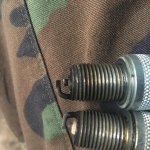your long term is too high.
bank 1 is trying to take fuel away and bank 2 is trying to add fuel.
When was the last time you took the valve covers off, remove the baffle plates, and thoroughly cleaned all the dried up oil and crud? If your crank case breather is not working properly the intake manifold is going to find another place to pull negative pressure in. Adversely if the the crank case breather system is blocked up its going to find the weakest seal to blow the positive pressure out.
I've said it way too many times here but without a smoke machine you will never pin point vacuum leaks. Spraying starter fluid leads you to a general area. If you have zero vacuum leaks then check the crank case breather system and the valve cover
baffles.
Only numbers you need to be watching is short term and long term. Unless you have a scanner that's also reading fuel trim set point your going to chase your tail. Don't even know if a T1 shows fuel trim set point. Basically the ecu bases long term from short term and that happens once the set point 'balances'. Usually once engine temp is reached the set point starts to settle after 5 or 10 minutes of idle and partial load conditions.
Find a shop with a smoke machine, pay them to smoke the intake. It will save you time trying to find any/all vacuum leaks. If there are no vacuum leaks AND the pcv system is working properly?
As long as you can get long term to 5 or 6 percent additive you'll be fine.
Maybe discostew knows, but if load percentage is actually partial load then that is way too high, should also be about 5-6% additive. Partial load is how much fuel is given while you are under light acceleration. Full load or wide open throttle is always a default fuel additive based on manufacturer.
I'm assuming load percentage is not actually fuel trim partial load. Load percentage is a generic obd block.
Partial load, regarding fuel trim additive, is EXTREMELY important. If the ecu adds too much fuel under partial load that's when you're going to have issues. That usually gets out of whack if there is a vacuum leak causing too much port velocity OR a bad MAF A bad MAF reads too much air and the ecu dumps fuel.
But like I said, load percentage generic obd is just a calculated load value and not actually partial load fuel trim.
